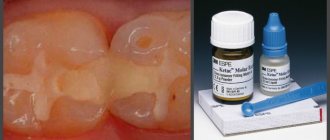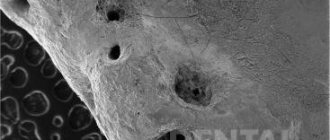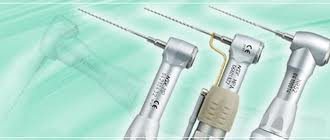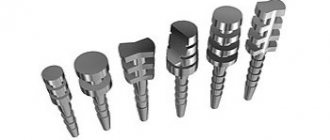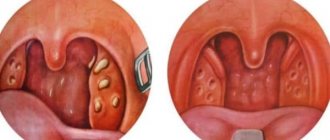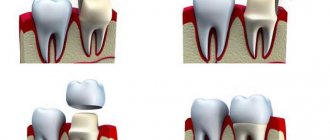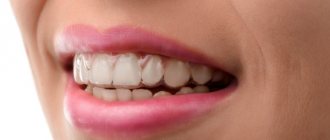Characteristics of the method
The use of devices that allow magnification of images of the operating area provides doctors with significant advantages in medicine.
It becomes possible to assess the condition of each tooth and perform complex manipulations, controlling every movement. Key factors that improve the quality of dental treatment and prosthetics: multiple magnification , good lighting , accurate and convenient positioning of the microscope.
In dental treatment, special dental microscopes are used - electronic optical devices that can magnify images 30 times or more. The microscope is brought to the surgical field using a pantograph, which in turn is attached in various ways: floor (bed), wall (brackets), ceiling; Thanks to the mechanism, the microscope easily takes the exact position above the tooth and is fixed in it. The microscope is equipped with a digital camera connection, which can be used to take photographs and record videos. An image of the treatment process is displayed on the monitor so that the assistant, whose presence is required, can navigate the doctor’s actions. Some devices are equipped with a monocular or binocular tube for an assistant to monitor the progress of treatment.
During treatment using a microscope, the patient is in a chair in the “lying” position, and a microscope lens is installed over the tooth being treated. The doctor sits behind the patient's head or to his right and conducts treatment through eyepieces. The assistant gives the dentist the necessary instruments. For the doctor who conducts treatment under a microscope, a work chair with special armrests and lumbar support is provided - this is necessary so that during long procedures the dentist does not get tired of sitting and there is no hand trembling.
Psychological comfort of the patient
Practice shows that many patients are afraid of various manipulations associated with dental treatment. But besides this, many people feel psychological discomfort when the dentist is in close proximity.
The Carl Zeiss dental microscope (and other models) is helping to change that game-changer. After all, when using it, the patient is in a chair, and the doctor is about half a meter away from him (or more), that is, all manipulations are carried out remotely. Thanks to this, the patient is not nervous and feels good.
Benefits of dental treatment under a microscope
Dental treatment using a microscope has the following advantages:
- The ability to see details hidden to the naked eye;
- Quick and accurate detection of enamel fractures and cracks, the first signs of caries;
- Minimizing damage to healthy tissue when preparing carious cavities;
- Enlarging the local area of the surgical field allows one to observe not only the oral cavity, but also to examine an individual tooth in detail;
- Improved lighting. Light is locally directed to the location of magnification. The backlight can be halogen, LED or xenon. Each type has its own advantages when performing different tasks;
- Better visibility of root canals during endodontic treatment, reducing the likelihood of perforation and facilitating unfilling and removal of broken instruments;
- Detailed visualization of anatomical structures during implant treatment;
- Monitoring and assessment of the condition of soft tissues;
- Detection of areas of loose filling during diagnostics and restorations;
- The ability to photograph and videotape the treatment without interrupting it. These materials are provided to the patient for his better understanding of the problem with which he consulted the doctor and the results of treatment;
- Detailed recording of diagnostic results and treatment process;
- Photo and video materials obtained during treatment can be used not only to achieve understanding between the doctor and the patient, but also for consultations with colleagues, presentations at scientific conferences, teaching students, and participation in research.
Canal treatment under a microscope
The dental microscope is used in various fields of dentistry, but its use is most effective in endodontic treatment - treatment of tooth cavities and root canals. The work of a dental therapist during endodontic treatment requires increased care, skill and “flair,” therefore the use of a dental microscope increases the success of endodontic treatment several times. Below is a short demonstration of the root canal treatment process under a microscope:
A dental microscope can increase the likelihood of success when:
- Searching for the mouths of canals, including additional and fourth ones;
- Detection of channel branches;
- Detection of pulp residues or carious lesions inside the canals;
- When identifying voids formed during canal filling (the latest techniques, such as injection gutta-percha, when used correctly, eliminate the formation of voids);
- When cracks are detected in the root canals that are not visible on x-rays.
Below is a list of dental operations, the implementation of which has an average and low percentage of successful prognosis with conventional treatment, but when using a microscope, the success rate increases:
- Working with the uncovered root tip;
- Unsealing and re-treatment of poorly treated canals;
- Removal of intracanal pins;
- Removing from the canal fragments of instruments broken during previous treatment;
- Closing perforations. Using the usual method, it is impossible to accurately localize the site of damage to the root canal, and even more so, to bring the instrument to it;
- Treatment of cysts and granulomas. Previously, when cysts and granulomas occurred, teeth had to be removed. Later, methods of therapeutic and surgical treatment appeared, and finally today, thanks to the use of magnifying devices, dentists are able to cure teeth that were previously considered hopeless.
The microscope allows you to reduce the number of medical errors and complications that often occur during root canal treatment in the usual way, “blindly”.
All branches and bends of the main and additional root canals are visible through the microscope, cleaning canals and carious cavities, removing old filling material and filling with new material is greatly facilitated, and objective control of its adherence to the canal walls appears. All this increases the quality of the dentist’s work, the service life of the filled canal and the restored tooth.
What is treated under a microscope in dentistry?
When treating caries, the doctor first installs a rubber dam. After this, he proceeds to sanitation of the oral cavity. In some cases cleaning is required. When the doctor is convinced of the effect of anesthesia, he begins direct treatment of caries.
Regardless of the extent of tissue damage, the dentist will first completely remove the affected areas. A microscope helps him with this. With pulpitis, an inflammatory process occurs in the pulp. Most often, the pathology occurs due to advanced caries and is accompanied by quite severe pain. If inflammation is not treated, the process will spread to bone tissue. Because of this, flux may appear. Thanks to a microscope, you can protect the roots and tooth from removal. The basis of high-quality treatment is a good filling of absolutely all root canals.
During their work, dentists often encounter hidden caries, microcracks, and various defects of teeth and gums. They are all very small and cannot be identified visually. Therefore, they cannot be cured at an early stage without special equipment. Using a microscope, the smallest sources of future pathologies are determined and easily dealt with.
The use of dental microscopes can be called a real breakthrough in modern oral treatment. The importance of preserving teeth for many years is very difficult to overestimate. New devices help in this matter.
Aesthetic restorations using a microscope
What criteria must the restoration meet:
The restoration, like a filling, must restore occlusion, not interfere with the natural closure of teeth, repeat the anatomical shape of the tooth in detail, and be reliable enough for the tooth to perform the function of biting or grinding food. Reliability is achieved through the complete implementation of all steps when placing a filling. Defects can occur when cleaning the surfaces of a prepared tooth. Using a microscope, before and after etching, the dentist is able to visually verify the absence of tissue particles or foreign materials. This undoubtedly improves the prognosis of treatment;
The restoration must match the natural color of the teeth and be invisible. Not only the color, but also other optical properties of the enamel (opalescence, transparency) must be reproduced, which is obviously easier to do if the work area is increased several times;
The junction of the restoration with the biological tissue of the tooth. A large gap at the junction will concentrate stress, become a place for the accumulation of bacteria and plaque and the development of caries, i.e. The more accurately the dentist “attaches” the edge of the filling to the tooth, the longer it will last. In this context, a microscope is an ideal instrument for monitoring the size of the joint. Similar logic is suitable for installing ceramic inlays or crowns.
When restoring the form and function of teeth through restoration, it is important to consider as many details as possible. This is possible by increasing the restoration area. With traditional treatment, the dentist's view is limited to what is reflected in the dental mirror or what he sees with his eyes. The use of a microscope allows you to expand the capabilities of the dentist and improve the quality of the filling being installed.
The use of a microscope in surgical dentistry
The microscope is also effective during surgical operations.
The use of a dental microscope makes it possible to make surgery minimally invasive, since it becomes possible to use microinstruments specially designed for microscopic dentistry, which are significantly smaller in size compared to traditional ones, and therefore cause less damage to oral tissue. Patients tolerate both the operation itself and the postoperative period more easily.
Features of working with a microscope
Dental treatment under a microscope has its own characteristics that must be taken into account when working:
- To work with a dental microscope, specialized training of the doctor and assistant is required;
- Adaptation of the dentist’s eyes to the device lasts about six months; during this period, the dentist may experience pain in the eyes when working with the microscope for a long time.
- The assistant must accurately respond to the doctor’s requests and place the necessary instruments in his hand.
- Conventional dental instruments are not suitable for treatment under a microscope, since their handle or the operator's hand may obscure the field of view; requires the purchase of new tools.
- The disadvantage of a microscope in root canal treatment is its ability to “see” only what is directly in the line of sight; when the canal is bent, the surface becomes inaccessible for viewing. In reality, in 90% of cases, the doctor’s gaze reaches almost to the apical part of the tooth;
- The patient is required to remain as still as possible.
- A dental microscope is an expensive device. This circumstance, as well as the need for special training of the dentist, increases the cost of treatment.
More and more patients understand that dental treatment under a microscope is better and more effective, so they are looking for clinics that have the necessary equipment and specialists. The use of a dental microscope in some cases is the only way to conduct accurate diagnosis and treatment and provide the patient with high-quality dental care.
Features and Applications
A dental microscope is a system of lenses with multiple magnification (from 3 to 25 times), mounted on a special tripod, and making it possible to conduct a detailed examination and perform complete and high-quality treatment.
If previously the doctor worked almost blindly through a mirror, now with optics he can see the treated area better. Thanks to the microscope, it became possible to more carefully and thoroughly treat the affected cavity without affecting living tissue.
Many models of the device are equipped with additional functions , for example, all stages of treatment are recorded, a well-lit and clear image of the surgical field is displayed on the monitor, and light filters are activated for accurate diagnosis.
You can also study in detail the color, relief, structure of teeth, the condition of tissues and canal walls, determine the quality of standing fillings and the degree of fit of orthopedic structures.
The endodontist can independently adjust the desired lighting and sharpness , obtaining a clear image of even the deepest canal with all its branches.
The scope of application of the device is extensive, i.e. it is indispensable in work requiring high precision performance, namely:
- diagnostics;
- endodontics
- periodontology;
- dental operations;
- restoration;
- surgery;
- prosthetics.
All manipulations performed under a microscope do not differ in technique from those usually performed by a dentist, but they are more comfortable for the patient.
During treatment, he is in a supine position, which is more psychologically comfortable and convenient. The lens of the device is placed at a distance of 20-25 cm from the face, and about another 35 cm is the device itself with eyepieces. Now the doctor’s face is located at a considerable distance (up to half a meter) and does not hang over the patient as before.
An assistant monitors the entire process together with the endodontist. He also provides the doctor with all the necessary instruments and medications.
Purpose and rules for applying rubber dam in dentistry, types of material.
Come here if you are interested in why a tooth might break.
At this address https://www.vash-dentist.ru/lechenie/zubyi/karies/klassifikatsii-po-mkb-10.html we suggest that you familiarize yourself with the features of the classification of dental caries according to ICD 10.
Cost of dental treatment under a microscope
The concept of the cost of dental treatment under a microscope, in most cases, does not make sense, because... There is a dental service that has a set price, it can be performed either with a microscope or without a microscope. In most cases, the cost of the service itself increases, this is due to two factors - depreciation of the microscope itself (the cost starts from 30,000 USD) and the large labor costs of the doctor.
However, the increase in cost will be minimal, and potentially, when using a microscope, the patient receives treatment at a qualitatively higher level, the result of which can be used longer; if you want, the return on investment when treating teeth using a microscope will be higher .
Using a microscope in implantation
Installing implants is a surgical procedure. Recently, some dental clinics that have a dental microscope at their disposal are looking for new opportunities for its use.
The use of a microscope is justified in microsurgery, namely vascular and neurosurgery, that is, where the essence of work is with elements that cannot be seen with the naked eye.
The protocol for installing artificial roots requires using tools that are clearly visible to normal vision. The most common implant sizes are 10 mm or more.
Thus, the use of a microscope in implantation can be recognized as a method of special choice for individual specialists.
